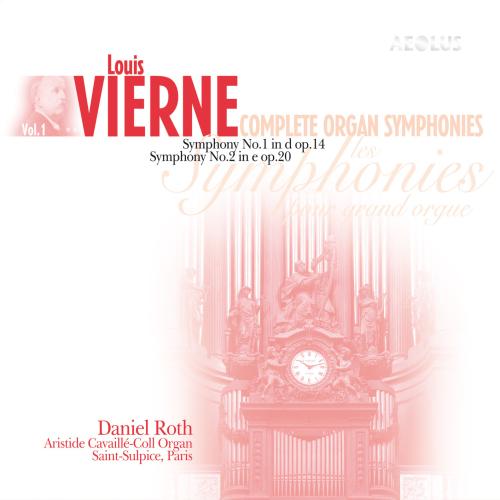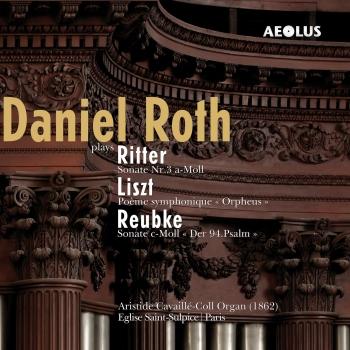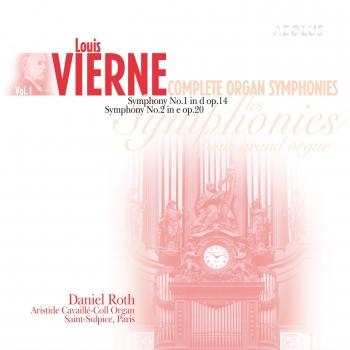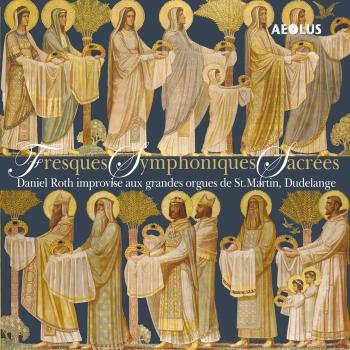
Vierne: Complete Organ Symphonies Vol. 1 (Remastered) Daniel Roth
Album Info
Album Veröffentlichung:
2005
HRA-Veröffentlichung:
07.12.2017
Label: Aeolus
Genre: Classical
Subgenre: Chamber Music
Interpret: Daniel Roth
Komponist: Louis Vierne (1870-1937)
Das Album enthält Albumcover Booklet (PDF)
- Louis Vierne (1870 - 1937): Symphony No. 1 in D Minor, Op. 14:
- 1 I. Prélude 08:44
- 2 II. Fugue 05:48
- 3 III. Pastorale 07:53
- 4 IV. Allegro vivace 04:39
- 5 V. Andante 07:06
- 6 VI. Final 07:15
- Symphony No. 2 in E Minor, Op. 20:
- 7 I. Allegro risoluto 07:50
- 8 II. Choral 08:52
- 9 III. Scherzo 04:10
- 10 IV. Cantabile 08:17
- 11 V. Final 08:36
Info zu Vierne: Complete Organ Symphonies Vol. 1 (Remastered)
„Listening to the organ works of Louis Vierne reminds me of the challenge of trying to capture dynamite in a bottle. Vierne has written music that can be explosive, almost larger than life. It takes every pipe of the mighty organ of Saint-Sulpice in Paris to capture the sound that emerged from Vierne’s imagination. Even in a recording as fine as this, we can only approximate the impact of these thunderous sounds echoing through the cathedral’s expanse, rattling the windows, shaking the walls.
Daniel Roth provides a welcome addition to the catalog. Here is a master organist, tackling two of the masterpieces of the organ literature. One sits back, reveling in the tonal splendor. In the first symphony, Roth allows Vierne’s menacing opening movement to build to a massive climax (although both Marie-Clare Alain and Daniel Chorzempa are slightly more menacing in this music). Roth’s second-movement Fugue builds to a magnificent conclusion. The third-movement Pastorale is appropriately peaceful while his Allegro vivace is fleet and electric and the fifth-movement Andante is nicely meditative. In the Final, Roth literally lets out all the stops. We close our eyes and almost imagine sitting in Saint-Sulpice, the sound sweeping over us. In my rational moments, I realized that there was a slightly excessive reverberation that somewhat mars this movement. Yet, in the end, this did not matter. In his recording, Gunther Kanzinger provides extra drama, aided by his quick tempos. (His recording of this symphony is 10 minutes shorter than Roth). But Roth brilliantly plays this amazing music.
If anything, Roth is even more impressive in the Second Symphony, which was composed in 1902, four years after the First Symphony. We can sense how, in those four years, Vierne had gained in maturity. Roth builds the second movement Choral to a mighty climax and then transports us with songlike flutes in the third movement Scherzo. We feel the flowing of melodic currents throughout the fourth-movement Cantabile, leading into the mighty Final. I really like Latry’s recording of this symphony. At the same time, it is hard not to be caught up by Kanzinger’s faster tempos and more intense approach. But overall, Roth won me over.“ (John E. Roos, Fanfare)
Daniel Roth, organ
Daniel Roth
ist "Titulaire" an der berühmten Orgel von Saint-Sulpice, Paris.
Es ist die Bewunderung für Albert Schweizer, den berühmten elsässischen Arzt, Theologen und Musiker, die Daniel Roth dazu bringt, neben Klavier und Tonsatz auch Orgel am Konservatorium seiner Heimatstadt Mulhouse zu studieren. Am Pariser Nationalkonservatorium werden ihm fünf „Erste Preise” zuerkannt, und zwar in den Disziplinen „Harmonielehre” (bei Maurice Duruflé), „Kontrapunkt und Fuge” (bei Marcel Bitsch), „Klavierbegleitung” (bei Henriette Puig- Roget), sowie „Orgel” und „Improvisation” mit Auszeichnung (bei Rolande Falcinelli).
Er studiert Interpretation Alter Musik und bereitet sich bei Marie-Claire Alain auf internationale Wettbewerbe vor. So wird er u.a. Preisträger des „Premier Prix des Amis de l’Orgue” und 1971 Chartres-Preisträger für Interpretation und Improvisation.
1963 wird er Co-Titulaire von Rolande Falcinelli an der Basilika Sacré-Cœur de Montmartre in Paris. 1973 tritt er Falcinellis Nachfolge an, bis er 1985 als Titulaire an die Kirche Saint-Sulpice berufen wird. Hier tritt er die Nachfolge Widors, Duprés und Grunenwalds an.
Er unterrichtet zunächst am Konservatorium von Marseille, dann an der Universität von Washington D.C., später in Strasbourg, dann in Saarbrücken und seit 1995 als Nachfolger von H.Walcha und E.Krapp an der Musikhochschule in Frankfurt/Main.
Er führt eine internationale Konzertkarriere als Solist, auch mit Orchestern. Darüber hinaus unterrichtet er regelmäßig auf Meisterkursen und erfreut sich zahlreicher Einladungen als Juror namhafter Wettbewerbe. Aufnahmen für Radio und Fernsehen gehören ebenso zu seinen zahlreichen Aktivitäten wie seine vielen CD-Aufnahmen, die Werken von Bach, Reubke, Liszt, Franck, Guilmant, Boëly, Saint-Saëns, Widor, Vierne, Dupré und Jolivet gewidmet sind.
Als Komponist schrieb Daniel Roth Werke für Orgel, Flöte und Orgel, Chor acapella, Chor und Orgel, Chor, Orgel und Solisten.
Booklet für Vierne: Complete Organ Symphonies Vol. 1 (Remastered)














